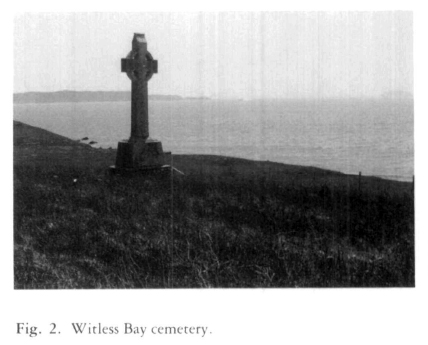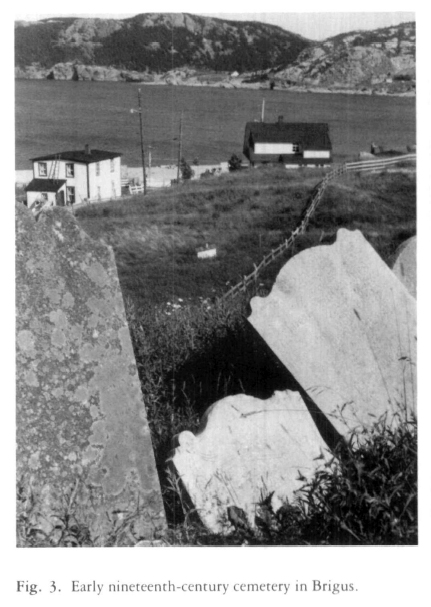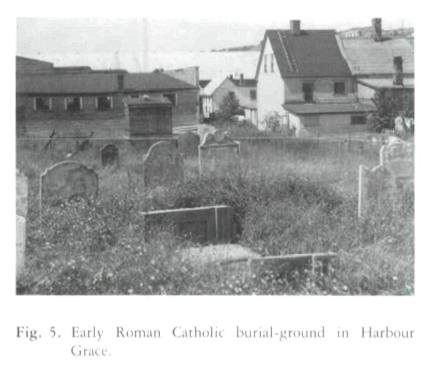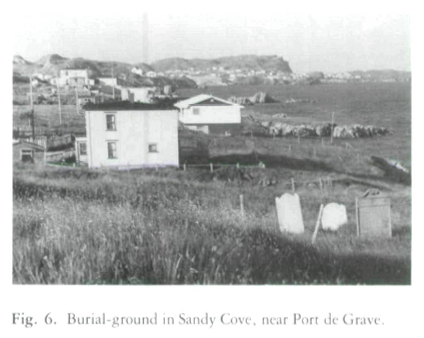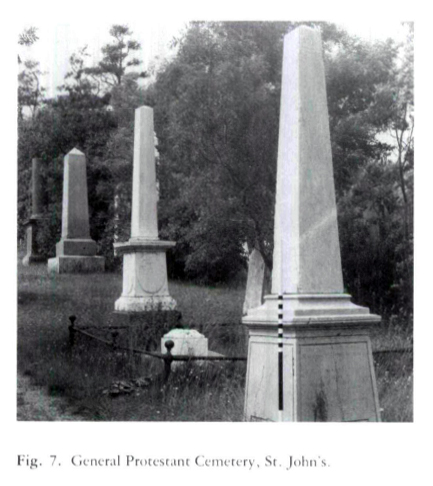Articles
The Transformation of the Traditional Newfoundland Cemetery:
Institutionalizing the Secular Dead
Abstract
The siting of the earliest cemeteries in Newfoundland communities was influenced by a number of local traditions: that the dead be buried on a hill, overlook the ocean, and be located in the midst of the community itself. With the arrival of clergy in the nineteenth century, and influenced by the cemetery reform movement in major urban centres, the location of the place of burial in the outport community changed. New cemeteries were created, either outside the immediate vicinity of the recently constructed church, or beyond the bounds of the living spaces of the community. As well, some denominations designated these spaces as sacred by consecrating them, thereby initiating strict rules as to who could be buried there. Instead of bringing the place of burial under complete church control, however, these requirements fostered a new set of esoteric local traditions. While spatially the dead had been removed from the community and placed under religious institutional control, local residents still managed to regard the cemetery in ways that maintained a personal link with the dead.
Résumé
Le choix de l'emplacement des premiers cimetières créés à Terre-Neuve obéissait à différentes traditions locales, notamment: que le mort soit inhumé sur une colline surplombant la mer et située au sein du village. Avec l'arrivée du clergé au XIXe siècle et sous l'influence des mouve-ments de réforme des cimetières dans les grands centres urbains, les villages de pêcheurs modifièrent l'emplacement des lieux d'inhumation. De nouveaux cimetières furent créés, à l'écart de l'église neuve ou en marge des lieux habités. Par ailleurs, certaines confessions consacrèrent les lieux d'inhumation, imposant des règles strictes quant à leur usage. Mais, plutôt que de placer les cimetières sous la domination totale de l'Eglise, ces interdits donnèrent naissance à de nouvelles traditions locales ésotériques. Quoique d'un point de vue spatial, les morts aient été mis à l'écart de la communauté et soient passés sous l'autorité institutionnelle de l'Église, les habitants réussirent à considérer le cimetière de façon à conserver des liens personnels avec leurs morts.
1 During the summer of 1848 the Anglican bishop of Newfoundland, Edward Field, visited many of the scattered communities that lay within his charge, sailing along the south and west coasts of the island, as well as coastal Labrador.1 Field preached, distributed Holy Communion, and celebrated Confirmation for these residents, who at the time rarely saw a clergyman, let alone a church leader. As well, he performed one other important religious function — he consecrated community cemeteries.2 Field's desire to officially sanction the places for the burial of the dead was not an isolated concern; indeed, the early nineteenth century in western Europe and other parts of North America saw an increasing obsession with the entire issue of planning and regulation of cemeteries. Religious and civic leaders became more and more desirous of imposing some kind of spatial order on the places where people were buried, wrestling with local practices and attitudes, until the norms of rationality would hopefully prevail over local custom and belief. Such a trend seems to be the case in rural Newfoundland.
2 Throughout the many small communities of outport Newfoundland, the cemetery has seen a change in what were considered the norms of spatial appropriateness that governed it since the earliest years of use. Residents of European origin, either summer fishermen or permanent settlers, obviously buried their dead in this New World outpost as early as the seventeenth century, yet documented places of burial usually date — using the surviving gravestones as evidence — from not much before the mid-eighteenth century.3 A series of cemeteries is still evident today in most communities, a group that in its spatial chronology mirrors the transformation of social attitudes toward burial spaces in each place. The basis for the comments in this study on spatial chronology come primarily from a survey of cemeteries conducted during the summer of 1974 in two areas of the province: the Southern Shore south of St. John's, which includes communities between Petty Harbour and Cappahayden; and the communities of western Conception Bay between Harbour Grace and Holyrood. Both areas had seen settlement from the early seventeenth century, with Europeans migrating from southwest England and southeast Ireland. This geographic sample has been supplemented by field work over the last twelve years on the Bonavista "Peninsula," Codroy Valley, and southern Labrador, as well as by documentary materials from the Newfoundland Archives4 and the Memorial University of Newfoundland Folklore and Language Archive.5 The same spatial transformations that occurred in these surveyed communities obviously went on in urban centres like St. John's; in these centres documentary sources are richer, but actual landscape evidence is more difficult to find because the need for living space has often obliterated early traces of cemetery patterns.
3 The changing forms of the traditional cemetery in the Newfoundland community are moulded by one very important factor. Although most outport communities examined in this current study had settlers living there since at least the seventeenth century, most did not have resident clergymen until the nineteenth century. Thus, the form that earlier cemeteries took was strictly determined by local practices, rather than by the powerful persuasion of any theologically tinged clergy. Early cemeteries that can still be seen today, therefore, were burial places spatially situated without the hand of organized religion to point the way.
4 The earliest cemeteries, used roughly from around 1750 to 1850, were influenced in their spatial location by attention to three concerns: they be situated on a higher level of ground; they be in sight of some important locus of human activity; and they be near the community.
5 Early cemeteries were situated attentive to a belief that the dead ultimately retain some personal concerns that they had while living. In most instances, this meant burial in a cemetery that overlooked the sea. Certainly, in many cases, it would almost be impossible that anything other than this might be the case, since the entire outport was oriented towards the water (figs. 1 and 2). However, there are certainly reports that the selection of such a cemetery site was intentional, and that the wishes of the dead were quite clear in this regard. For example, a resident of Branch, St. Mary's Bay, reported that:
6 Many older people say the graveyard must be where the dead can see the boats come in from fishing. The old graveyard is situated within sight and sound of the sea just across from the 'pond' where the boats dock. Most of the older people were fishermen and would have liked to remain near the sea.6
7 Women who spent long hours working in the fishery had a similar desire, according to several reports, to be buried where they could see the water.
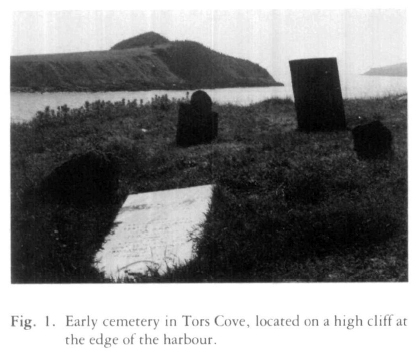 Display large image of Figure 1
Display large image of Figure 18 Besides this desire to locate a cemetery in view of the ocean, many early cemeteries were also situated on hills. This may simply be explained by the fact that Newfoundland communities are often located on hilly ground (fig. 3). As well, such land was possibly not considered useful for ordinary purposes such as for gardens or to dry fish. Vet, the cemetery was often put on a point of ground that was high even in relation to the rest of the land in the community. Obviously, this practice draws on the long Western tradition of a preference for hilltop burials7 and may also have had more local influences.
9 Cemeteries in Newfoundland were likely placed on hilltops because of the damp climate; the grave could become filled with water even after burial was completed. There are reports of graves having to be bailed out before they were used,8 and placing a coffin in a grave filled with water was certainly considered a sign of disrespect.
10 Of all the values and concerns revealed by the study of older cemeteries one stands out: burial was believed to most appropriately take place in the midst of the living. In all the surveyed communities, the earliest site for burials was almost always in a cemetery contiguous to the actual living spaces (figs. 4 and 5). In certain instances, this involved a series of scattered family or neighbourhood burial plots (fig. 6). More frequently, however, it took the form of a single cemetery, in some cases, where people of different denominations were buried. The cemetery usually was in full view of daily community activity, situated in a prominent place that visually spoke of the ongoing presence of the dead in normal life.9
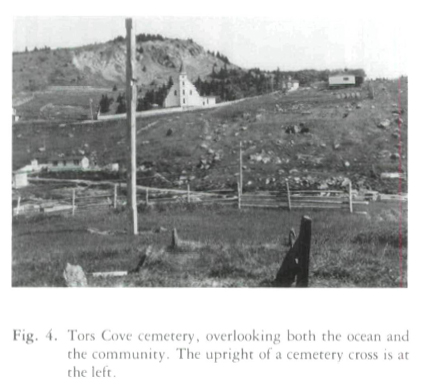 Display large image of Figure 4
Display large image of Figure 411 These centrally located cemeteries, often on a hill overlooking the water, obviously had become the accepted spatial locus for burial in the early years of Newfoundland permanent settlement. Local traditions report burial places in anomalous spaces, plates not in the midst of community life. These "cemeteries," whether they were really used for burials is often unclear, are not considered as an appropriate location for the dead; they are said to contain the remains of those who died under unusual circumstances — shipwreck or epidemic — or to be Indian burial-grounds.10 Located in remote coves or on hillsides quite removed from the community, these cemeteries have no markers to give evidence of burials; depressions in the earth are often pointed out as proof of burials.
12 The first half of the nineteenth century, the time when the early cemeteries in outport communities were being used, saw a movement throughout the British Isles and North America of what is often referred to as the "rural cemetery movement." Spurred on by landscape reformers like J.C. Loudon, and an increasing compulsion for hygiene in all areas of life, there was a growing concern that cemeteries were becoming overcrowded, that they were endangering the health of residents who lived nearby, and that they should be more closely regulated in spaces away from residential areas.11 Largely an urban phenomenon, cities such as London, Boston and Toronto developed new burying-grounds that could follow what were considered these more hygienic norms.12
13 Newfoundland certainly was not untouched by this movement. A growing concern over the state of cemeteries in St. John's is evident in a series of articles published in local newspapers that described the reform measures taken by some cities to eliminate burying-grounds from the midst of the living. Excerpts of accounts from British publications describing the major reforms that transformed a Glasgow cemetery into a park-like setting, or the new cemetery built in Liverpool, obviously were aimed at convincing St. John's readers to push for similar reforms.13 This movement in St. John's finally culminated in "An Act to Prohibit Interments within the Town of St. John's," which was passed in 1849,14 forbidding burials within the city's limits and establishing four new cemeteries — two Roman Catholic establishments (Mount Carmel and Belvedere), one Anglican (Forest Road), and one Dissenter (General Protestant) (fig. 7) — outside the inhabited spaces. These new park-like settings were certainly quite popular, for some city residents obviously moved burials from their older cemeteries to these spaces.
14 The reform movement that transformed the cemetery landscape of St. John's, the pushing of the visible landscapes of death beyond the daily life of ordinary citizens, coincided with another major shift in Newfoundland society, a shift that was occurring primarily in the rural areas outside the city. As the nineteenth century wore on, clergymen became permanently established in many communities, and all aspects of daily life became increasingly under the purview of the representatives of official religion. Part of this regularization involved beliefs regarding death and the burial place.
15 The St. John's landscape gradually evolved until the early cemetery patterns disappeared; today many early cemeteries have been built over and are largely forgotten. But the outport landscape still clearly shows the changes burial places underwent through the nineteenth century. The arrival of the permanent clergyman had a major impact on the burial pattern in the outport community. Partly fueled by the rural cemetery movement, and partly through a desire to impose order on all aspects of community life, in outport after outport this representative of the church usually made sure that some control was imposed on local mores. Numerous accounts remark on the lifestyles that offended the sensibilities of the educated European.15 One of the easiest aspects to bring under quick control was norms relating to the burial of the dead. With Anglican and Methodist denominations, cemeteries were usually created that surrounded a newly built church building. In most outport communities, the time of church construction can be determined quite readily from the dates of the earliest gravestones located in the churchyard outside. The establishment of the church was linked with the creation of a churchyard; the church building surrounded by place of burial became one spatial unit.
16 In Roman Catholic communities, a new burial-ground was often situated at some distance from the settled areas of the community. In the case of Petty Harbour, for example, Bishop Fleming established a cemetery a mile or so from the community, in part out of concern for the perceived health hazards of a cemetery in the midst of the living.16 All along the Southern Shore, a predominantly Roman Catholic region, church-organized cemeteries are found removed from the community, while the older places of burial can still be seen nestled within living areas.
17 However not only the Roman Catholic denomination, which obviously had less a concern about having a church-churchyard spatial unit, created cemeteries away from the community. As the nineteenth century progressed, some Anglican and Methodist churches did not continually expand their churchyard, in some cases, no doubt, because contiguous land was not available. In these instances, cemeteries were also created at the fringes of the community, again moving the dead out of the realm of daily life. This change in location was probably at times met with some resistance, for it no longer permitted residents to address the concerns of the dead, such as the desire to be buried on a hilltop overlooking the water. One example may be typical of many. In Pouch Cove, an Anglican church was built around 1840, and burial in the churchyard replaced burial on a nearby hill overlooking the water. In 1914, the clergyman decided to stop burials in the churchyard since it was almost full, and started a new burial-ground on a high hill overlooking the community. Even before the churchyard was completely filled, some residents were expressing a desire to be buried on this hill rather than around the church. When questioned about this, a resident recently explained:
This feeling, hearkening back to the earlier spatial pattern, was so intense that one woman decided she wanted to be buried on this hill rather than with her husband who had been interred several years before in the churchyard.
18 The arrival of clergy meant one other important element of regulation with regard to the burial of many of the dead. The organized churches, following a long tradition, dictated that the actual place where people were buried was sacred space, and a specific ritual was actually conducted to consecrate the place of burial, conferring on it this special status. Thus, cemeteries could be transformed only by a church official into this special category, and once buried, the departed faithful would be incorporated into a sacred community of the dead under this institutional control.17
19 Along with this necessity to have officially sanctioned places of sacred burial came an important corollary. Since only the church had the power to consecrate the cemetery, and thus had control over it, officials could determine who would be permitted burial within its boundaries. The unsanctified dead — those who had died in some socially unacceptable way, such as suicides, murderers or un-baptized children, or those who were not considered members of the particular religious group — were usually prohibited from being buried in this consecrated ground, denying them the necesary rites of incorporation into the community of the dead.18
20 A report from the Bonavista Peninsula is a common one:
A resident of Portugal Cove, just outside of St. John's, noting recent changes regarding burial in consecrated ground remarked:
In short, such unsanctified dead were often placed in graves not only outside the community, but also outside the community of the dead as well, the extreme form of ostracism by religious officials.
21 Yet, because of this insistence on the need for burial in consecrated ground by local chuch officials, incidents sometimes occurred that revealed the tensions between the persistent desire to have residents buried with the others of the community of the deceased, and the official desire to regulate the space of the dead. Several reports point to the kinds of conflicts that were typical.
22 A local resident of Pouch Cove related that when he was young, a fisherman from the community was drowned one fall, and his body could not be located before the harbour froze. In the spring, a body was discovered floating in the bay. A canvas sail was slipped under it, and it was lifted from the water. Church officials had decided that it should be buried outside the churchyard, since it could not be properly identified to determine whether, indeed, it was the suspected member of the church's congregation. The widow of the drowned fisherman, however, was convinced that this was her husband's body, and that it should be buried in consecrated ground. No positive identification could be made, but officials finally decided to yield to the widow's pleadings, and the body was buried in a corner of the churchyard. The grave, however, was to remain unmarked, a compromise to church officials that would maintain the sacred nature of the space.
23 In a more extreme case, however, there was a clearly felt need to include the deceased with the other members of the community of the dead, ignoring the fact that only the specific area of ground had been designated as sacred:
Local belief obviously considered the inclusion with other of the community's dead more important than whether or not the exact piece of ground had been designated sacred boundaries of inclusion winning out over theological transformations of space.
24 The churches sometimes placed objects in these new cemeteries to underline their connection with official beliefs, to signify their sacred character and to emphasize their institutional control. In some cases, as in the cemetery at Bay Bulls, a type of large ornamental gate marked the entrance, and actually gave the space a religious name (fig. 8). Naming per se was a linguistic manifestation of institutional control, for the earlier cemeteries in each community had no names.22 Large crosses were often placed in Roman Catholic cemeteries, usually at some central location (fig. 9).23 Although the church had theological reasons why such crosses added to the sanctity of this space, local explanations often developed to explain their presence. For example:
Indeed, the increasing control exercised over cemeteries by local churches — removing them from the community, designating their space as sacred, and excluding the socially unacceptable — did not mean that local practices were obliterated. Local beliefs persisted, although obviously not encouraged by official church teachings, and some components of local practices relating to the cemetery still remained governed by community traditions.
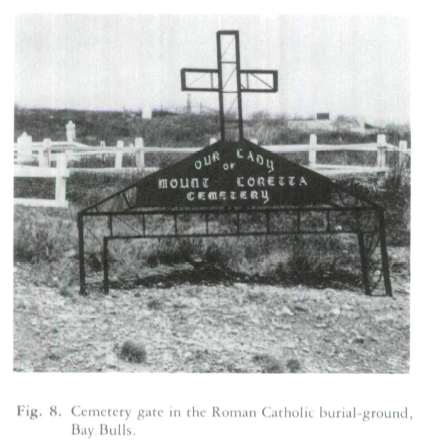 Display large image of Figure 8
Display large image of Figure 8 Display large image of Figure 9
Display large image of Figure 925 Designating the place of burial as sacred ground by church officials encouraged people to consider the actual objects in that space as potentially sacred, with a wide range of attendant beliefs. The soil of the cemetery might be considered powerful,25 and thus the actual vegetation in this space as sacred as well. Things found in that space, because of their sacred nature, should remain where they are, and their removal might cause potential harm. Ironically, while the rural cemetery reformers might have emphasized that the sacred nature of the cemetery required that it be kept free from uncontrolled growth, local traditions often considered such feelings in ways quite opposite, and many sections of cemeteries are still characterized by an overgrowth of weeds and brush (fig. 10). Disturbing plants, for some residents, would be paramount to disturbing sacred ground, and therefore they were not to be touched. Primary among the kinds of vegetation that must be left undisturbed were blueberries; a report from a Bishop's Falls resident is typical:
The removal of any object from a cemetery was taboo; a resident of Grand Falls, for example, reported that as a child he once picked flowers from a cemetery and brought them home with him. His father became very upset when he noticed this, and angrily demanded that the child throw them away.27 A resident of Bishop's Falls also mentioned that "my grandfather always told me it is bad luck to carry anything out of a graveyard."28
 Display large image of Figure 10
Display large image of Figure 1026 If church officials could gradually bring the spatial location of the outport cemetery under their control, local traditions still held sway with more specific spatial issues such as grave orientation. In the British, Irish and Newfoundland traditions, graves have usually been oriented on an east-west axis, connected to the general belief in the resurrection of the body on Judgement Day. The dead are customarily buried facing the east, and Walter Johnson cites several early church leaders who commented on this practice. Durandas claimed that the "eastward position is properly assumed in prayer." Bede stated that the "Sun of Righteousness" will come on the last day, and therefore the dead should face the sunrise. Reference was also made to Zechariah's prophecy, which refers to Christ's coming on the last day, standing "upon the Mount of Olives, which is before Jerusalem on the East."29 The tradition of burying the dead facing eastward is much older than Christianity, however, and it is the proper orientational form reported for most of the British Isles and North America.30
27 Most Newfoundland burials followed this east-west orientation, but often not for the reasons offered by official church theology. In Western Bay, for example, a man reported that the corpse must face the east because this was "where Our Lord was born."31 In Hermitage Bay, a man stated that burial had to take place with feet pointing to the entrance to the cemetery. In this way, "when the dead rise again they will be facing the entrance."32 In Twillingate, a resident explained that the graves face east because "Christ rose facing east (His tomb being toward the east). Also when you are alive you walk feet first as you do on earth so you should do in death."33
28 In the British Isles, the maintenance of this proper east-west orientation was considered essential to the salvation of the dead. Only those who were facing the east would hear Christ's call to arise on Judgement Day. Burials along other axes were reserved for those who would be excluded from future heavenly reward. Thus, graves with a north-south orientation were sometimes used in England and other parts of North America for suicides, murderers and dissenters.34 Like the prohibition of interment in consecrated ground, this form of burial was used for those considered unworthy of being a part of the normal community of the dead.
29 In contrast to these other regions, the use of this north-south orientation for undesirables has not been reported in Newfoundland. In fact, there have been several accounts that north-south orientation was the accepted burial mode in various communities. A comment from a resident of Old Perlican is typical:
The use of north-south orientation as the burial norm has been reported from all parts of the island.36
30 Obviously, local orientational traditions could be much stronger than official church positions. Clergymen could spatially regulate where the actual cemetery should be located, conferring on it a sacred status which permitted officials to decide ultimately who gained entry and who did not. But local traditions obviously were still strong enough to guide what was considered the proper burial orientation of the individual. While church officials were granted a say in the spatial regulating of the community of the dead, local people still maintained control over the fate of the individual.
31 Throughout the nineteenth century, then, a spatial dichotomization occurred in community after community,37 removing the dead from places of daily visibility to areas outside the realm of everyday life. Regularization by institutional mandates led to this major transformation of the cemetery as cultural landscape. The early cemeteries in each community, now no longer used, functioned more as historic sites relating to the general past than as burial-grounds having a connection with actual living relatives; they were now places of the collective dead rather than individual loved ones.38
32 The creation of the later cemeteries, in their new locations, with various religious rules and regulations, was fostered, it seems by an increasing concern to bring aspects of outport life under religious control. Like missionary efforts in far-off lands, visiting clergy found many local customs bordering on a state of "primitivism,"39 in need of drastic and major change. The regimentation of the death space was part of this crusading effort to eliminate what were considered elements of the irrational in the outport community.
33 Ironically, however, this regimentation spawned a new set of attitudes and beliefs that was equally beyond the scope of institutional control. Before the arrival of the local clergy and the pleas of Victorian cemetery reformers, no theological guidelines existed, and cemeteries were shaped largely by non-religious concerns. However, with official theology, which espoused the need for burial in consecrated ground, came an entirely new set of concerns, and ironically just as many were beyond the reach of complete regulation. Official teaching did not eliminate the local and idiosyncratic; it merely replaced one set of concerns with another, a trend not unknown in the general history of Western cemetery development.40
34 This spatial dichotomization, then, did not lead to a cultural dichotomization when it came to the community of the dead. Although the dead had been removed from the living spaces of the community, they were still of prime concern. Removing and regularizing the dead did not eliminate local belief traditions; rather, a new set of concerns was added to those already existing. The movement to transform what were originally merely secular dead into dead deemed sacred by religious institutions contributed to increased beliefs relating to the cemetery landscape, even if it had now been removed from a central spatial focus. While removal of the place of burial from the midst of the community indicates the general reforming tendencies of clergy and landscape planners in the mid-nineteenth century, the local beliefs, some surviving from before this era of reform, that are still widespread show how much a part of daily life the dead in a Newfoundland community continue to be.
